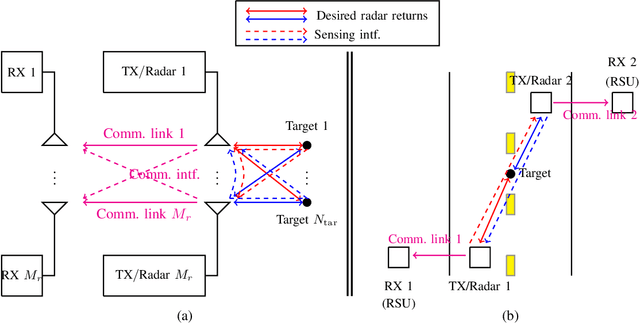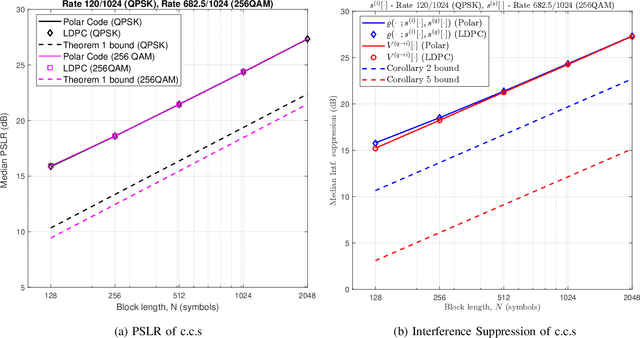Xueru Li
The Optimal Tradeoff Between PAPR and Ambiguity Functions for Generalized OFDM Waveform Set in ISAC Systems
Mar 27, 2025Abstract:Integrated sensing and communications (ISAC) has been identified as one of the six usage scenarios for IMT-2030. Compared with communication performance, sensing performance is much more vulnerable to interference, and the received backscattered sensing signal with target information is usually too weak to be detected. It is interesting to understand the optimal tradeoff between interference rejection and signal strength improvement for the best sensing performance, but unfortunately it still remains unknown. In this paper, the trinity of auto-ambiguity function (AF), cross-AF and peak-to-average-power ratio (PAPR) is proposed to describe the interference and coverage related aspects for ISAC systems where multi-carrier waveform is usually assumed. We extend the existing orthogonal frequency division multiplexing (OFDM) waveforms in 5G to a generalized OFDM waveform set with some new members and a unified parametric representation. Then the optimal Pareto tradeoff between PAPR, auto-AF and cross-AF (i.e., the union bound) is developed for the generalized OFDM waveform set. To achieve the optimal Pareto union bound with reasonable computational complexity, we further propose a framework to optimize waveform parameters and sequences jointly. Finally, some practical design examples are provided and numerical results reveal that significant improvements can be achieved compared to the state-of-the-art 5G waveforms and sequences.
Sensing using Coded Communications Signals
Sep 09, 2022



Abstract:A key challenge for a common waveform for Integrated Sensing and Communications (ISAC) - widely seen as an attractive proposition to achieve high performance for both functionalities, while efficiently utilizing available resources -- lies in leveraging information-bearing channel-coded communications signals (c.c.s) for sensing. In this paper, we investigate the sensing performance of c.c.s in (multi-user) interference-limited operation, and show that it is limited by sidelobes in the range-Doppler map, whose form depends on whether the c.c.s modulates a single-carrier or OFDM waveform. While uncoded communications signals -- comprising a block of $N$ i.i.d zero-mean symbols -- give rise to asymptotically (i.e., as $N \rightarrow \infty$) zero sidelobes due to the law of large numbers, it is not obvious that the same holds for c.c.s, as structured channel coding schemes (e.g., linear block codes) induce dependence across codeword symbols. In this paper, we show that c.c.s also give rise to asymptotically zero sidelobes -- for both single-carrier and OFDM waveforms -- by deriving upper bounds for the tail probabilities of the sidelobe magnitudes that decay as $\exp( - O($code rate $\times$ block length$))$. This implies that for any code rate, c.c.s are effective sensing signals that are robust to multi-user interference at sufficiently large block lengths, with negligible difference in performance based on whether they modulate a single-carrier or OFDM waveform. We verify the latter implication through simulations, where we observe the sensing performance (characterized by the detection and false-alarm probabilities) of a QPSK-modulated c.c.s (code rate = 120/1024, block length = 1024 symbols) to match that of a comparable interference-free FMCW waveform even at high interference levels (signal-to-interference ratio of -11dB), for both single-carrier and OFDM waveforms.
 Add to Chrome
Add to Chrome Add to Firefox
Add to Firefox Add to Edge
Add to Edge